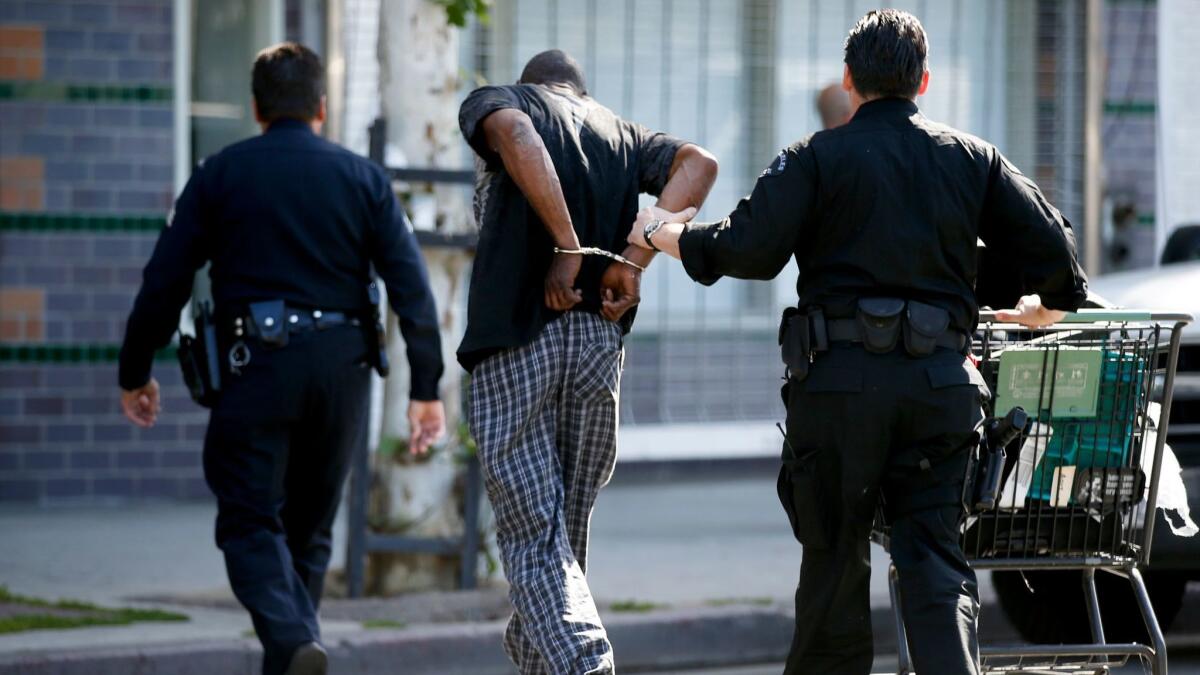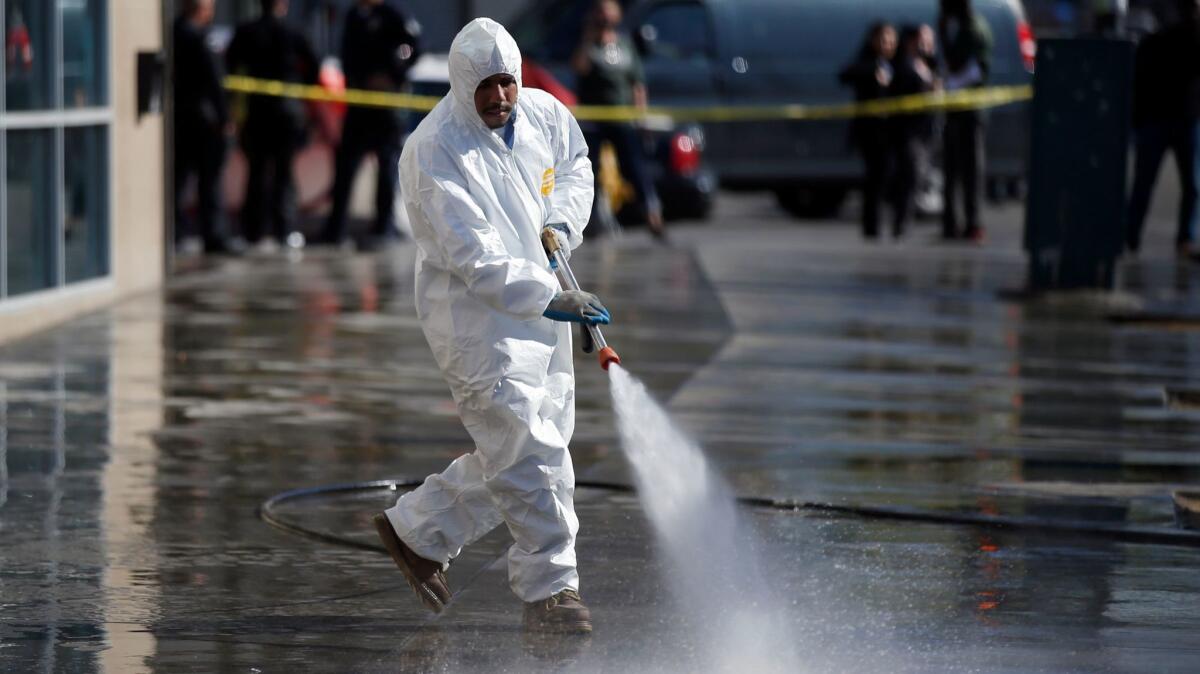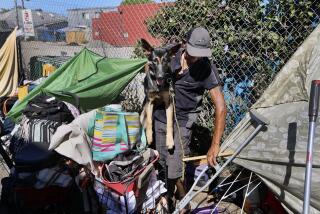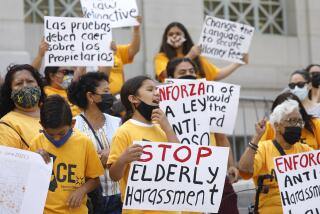Huge increase in arrests of homeless in L.A. — but mostly for minor offenses

Arrests of homeless people in Los Angeles have jumped 31% since 2011, a Times analysis of police data shows.
- Share via
Los Angeles police found Reed Segovia slumped in a folding chair near the Venice boardwalk early one spring morning in 2016 and shook him awake.
The officers handed the homeless street artist a ticket for sleeping on the sidewalk.
For the record:
2:00 p.m. Feb. 14, 2018An earlier version of the graphic with this article listed incorrect data for arrests in 2011.
Three months later, LAPD officers were citing Segovia again when they discovered an unpaid ticket for sleeping on the beach. This time, they handcuffed him, loaded him into a squad car and took him to jail.
L.A. officials have denounced “criminalizing” homelessness. But as Los Angeles struggles with a growing homelessness crisis, arrests of homeless people have gone up significantly, a Times analysis of police data shows. And the most common offense — the one Segovia was arrested for — was failure to appear in court for an unpaid citation.
Officers made 14,000 arrests of homeless people in the city in 2016, a 31% increase over 2011, the Times analysis found. The rise came as LAPD arrests overall went down 15%. Two-thirds of those arrested were black or Latino, and the top five charges were for nonviolent or minor offenses.
In 2011, 1 in 10 arrests citywide were of homeless people; in 2016, it was 1 in 6.
Los Angeles has more than a dozen “quality-of-life” laws — restricting sleeping on the sidewalk, living in a car or low-level drug possession, for example — that police enforce against homeless people, usually with a citation.
The tickets themselves typically start out at less than $100, but often top $200 or even $300 once court fees are added. Tickets pile up, and homeless people go to jail for not paying for offenses that warranted only citations.
“To pay $400 and be serving jail time because you had the audacity to sit on the sidewalk because you’re homeless … that’s just not justice,” said attorney Colleen Mullen, who has defended homeless clients against tickets.
Los Angeles Police Department officials attribute the rising arrests to the spread of homelessness and related crime. City officials say they have to balance the rights of homeless people against the quality of life and safety of the whole community.
“What we’re trying to do is our best to serve and solve a complex problem that is far beyond what we have been given the tools and mechanics to fix,” Cmdr. Todd Chamberlain, the former head of LAPD homelessness efforts, said in an interview.
But tickets catch homeless people in a revolving door of debt and arrests that can disqualify them from housing and jobs and prolong their homelessness, advocates and federal officials say.
The Times analyzed jail bookings provided by the LAPD from 2011 to 2016 — the last year with consistent data — counting those with a “transient” address as homeless.
A spokesman for the LAPD, whose officers made 90% of the city’s homeless arrests in 2016, said that methodology inflated the number because people who simply refused to give officers an address were also labeled as transient.
But the LAPD said in 2015 that a transient address “very likely” meant that a person was homeless, according to a report by then-City Administrative Officer Miguel Santana. Counting transients probably produced “an underestimate” of homeless people, the report said.

Mayor Eric Garcetti applauded recent LAPD reforms in dealing with homeless people but said officers still were making too many homeless arrests.
“The department needs to get with the program, and I’m going to make sure it does,” Garcetti said in an interview last year. “If these numbers are a trend — and quite frankly, if it’s not a trend — there are probably too many people being arrested.”
Segovia, who sells his artwork on the Venice boardwalk, has received as many as a dozen tickets, his lawyer said — mostly for sleeping, smoking and letting his artwork spill out of his boardwalk vendor space — and has gone to court five times to clear his record. He rolls his eyes at his multiple treks through the legal system.
“What was accomplished?” he asked. “Nothing.”
Fees can mount for unpaid tickets
Many residents and businesspeople welcome quality-of-life enforcement to clean up the streets. Police and some advocates see enforcement as a tool to persuade homeless people to move to shelters or accept other services.
“If the only way you can get someone in to talk about services is to have them get a ticket, then it’s a good thing,” said Betsy Starman, a downtown resident and homeless advocate.
But California lawmakers have piled on fees and assessments that make the state’s ticket penalties among the stiffest in the country, according to a study in May by the Lawyers’ Committee for Civil Rights of the San Francisco Bay Area.
The base fine in L.A. for sleeping or lying on the sidewalk, for example, is $35, but fees take the total to $238, L.A. County Superior Court spokeswoman Mary Hearn said in an email. A $300 “civil assessment” and other levies can be added, more than doubling the financial stakes.
“You or I can pay them, but these people can’t do that,” said attorney Andrew Chen, who ran a Venice citation clinic for homeless youth.
What we’re trying to do is our best to serve and solve a complex problem that is far beyond what we have been given the tools and mechanics to fix.
— Cmdr. Todd Chamberlain, former head of LAPD homelessness efforts
If anyone, homeless or not, misses the deadline to appear in court on an unpaid citation, the Superior Court automatically issues a bench warrant for his or her arrest. A decade ago, L.A. Superior Court computers were spitting out 8,000 bench warrants a week for failure-to-appear charges, according to a 2014 California Supreme Court opinion. Annual revenue from such complaints exceeded $75 million, the opinion said. (The court did not provide more recent figures.)
“It’s all about generating revenue for the courts,” said former Fresno County Traffic Court Commissioner Robert J. Thompson.
Most homeless people spend no more than a couple of days in jail on warrants. Judges can cancel some fees or order community service.
But fines are so high, and community service pay scales so low, people can face “a daunting number of hours” to work off their debt, according to an April report commissioned by state Chief Justice Tani G. Cantil-Sakauye. The report recommended fewer civil assessments and more fee reductions.
Judges in San Francisco stopped issuing bench warrants for unpaid quality-of-life tickets in 2015. In 2016, the court canceled more than 60,000 warrants, fines and fees, saying the penalties were unfair to poor people and the debt was unlikely to be collected.
Beginning in January 2016, Los Angeles Superior Court reduced failure-to-appear citations from misdemeanors to infractions.
But “there remain thousands in our system that were issued as misdemeanors prior to that date,” and the court continues to automatically issue arrest warrants for failing to pay the citations or report to court, said Hearn, the court spokeswoman.
“The Los Angeles Superior Court follows the law in these cases,” Hearn said.
A maze of courthouses and systems
Many homeless people fear theft or confiscation by the city if they leave their belongings unattended while they go to court, said Wendell Blassingame, a skid row advocate.
They may lack internet access to make online payments or an address where they can receive court reminders. And tickets and warrants don’t always show up on the court’s citation website, multiple lawyers said.
Figuring out where to go can also be a challenge.

Infraction tickets from Venice are filed at the Beverly Hills courthouse but tried in Santa Monica, while misdemeanor citations for the same violation — sleeping on the beach, for instance — are handled at the airport court. Misdemeanor citations issued in Malibu go to the Van Nuys courthouse, a 70-mile round trip that could take hours by bus.
People generally have 90 days to pay tickets, but officers sometimes shorten that window.
Merrian Cruse had only a month to clear up a June 2016 ticket for failing to take her skid row tent down by 8:30 a.m. LAPD spokeswoman Patricia Sandoval said she did not know why the due dates were cut short.
Adding to the confusion, officers can take up to a year to submit citations to the court — or never file them at all.
“You’re told you have to check every two weeks for a year,” said Noah Grynberg, another lawyer who volunteers to represent homeless people in ticket court. “Nobody’s going to do it.”
One of Grynberg’s homeless clients, Aaron Dollard, said he spent a year watching for a ticket that never appeared. “It made me feel like a criminal,” Dollard said.
Hearn said citations are “very clear” on when and where to report.
“If an individual contacts the court and his or her citation is not in our system, court personnel will direct that person to the issuing police agency to inquire as to the status of the citation,” she added.
The role of police evolves
Homeless enforcement in Los Angeles has evolved over the last 35 years from openly punitive measures to softer approaches.
Former Chief Daryl F. Gates swept up scores of those he referred to as “the so-called homeless,” carting their things off in skip loaders. Under the 2006 Safer Cities Initiative, then-Chief William J. Bratton sent a special detail of 50 officers to skid row to enforce minor violations.
The LAPD said Safer Cities reclaimed public space and allowed agencies to serve homeless people without fear of crime. Police teams also helped fuel the massive gentrification that swept through downtown Los Angeles.
But a UCLA law school study found that officers were handing out 1,000 citations a month and jailing those who didn’t pay them, many of whom later returned to the streets. The city lost several civil rights lawsuits over police crackdowns on skid row.
After Garcetti took the mayoral office in 2013, he and other officials began saying that enforcement was not the answer to homelessness.
“We can’t simply criminalize homelessness,” Garcetti told National Public Radio in 2015.
The city scaled back some punitive measures. In 2014, City Atty. Mike Feuer asked the LAPD to reduce quality-of-life citations from misdemeanors, which can draw jail time, to infractions. But police continued to hand out misdemeanor tickets to homeless people like Robert L. Smith, who was cited in July 2016 for illegal possession of a Target shopping cart.
Rob Wilcox, Feuer’s spokesman, said police still can issue misdemeanors in cases with “extenuating circumstances,” adding, “When individuals break laws, there need to be consequences.”
Feuer also revived citation clinics to help homeless people resolve ticket backlogs through community service or enrollment in rehabilitation programs. In their second year, the clinics, staffed by the city attorney’s Homeless Engagement and Response Team, or HEART, enrolled 825 people and resolved citations for 531. But dismissing tickets can take months, and the clinics can’t take care of ticket warrants.
Safer Cities was rebranded as RESET — the Resources Enhancement Services Enforcement Team — with a mission “to protect and serve the skid row community by utilizing outreach and service providers.” RESET pledged to ease up on arrests for petty offenses, and the LAPD ordered all officers to treat homeless people with “compassion and empathy.”
On skid row, officers switched from yellow to red crime tape to rope off homeless cleanup sites.
“Honestly, it’s a perception thing,” then-Central Division LAPD Capt. Howard Leslie, now a commander, said in 2016.
Beginning that year, the LAPD began rolling out Homeless Outreach and Proactive Engagement, or HOPE, teams to conduct encampment sweeps. The teams — comprised of police officers and sanitation, mental health and homeless outreach workers — are focused on bringing services, not enforcement, to homeless people, the department said.

The city also adopted new laws restricting living in vehicles and storing tents and oversize belongings in the streets. LAPD Chief Charlie Beck, in an August report to the Police Commission, said arrests of homeless people were up 49% in the first half of 2017, which he attributed in part to differences in how police reports on homeless people are coded.
But an October study by UCLA researchers largely echoed The Times’ findings of a six-year rise in arrests of homeless people, and a December follow-up report found the arrests continued to climb in the first half of 2017, to nearly 20% of the LAPD’s total bookings.
“Policing of houseless people is becoming a larger share of what the LAPD does,” said UCLA professor Kelly Lytle Hernández, interim director of the Ralph J. Bunche Center for African American Studies, which released the reports.
Many officers have embraced helping homeless people, but some are as frustrated as Segovia at the arrest merry-go-round.
Old tickets can loom for years
Crackdowns may ebb and flow, but unpaid tickets live on for years.
After his July 2016 arrest, Segovia pleaded no contest to sleeping on the beach and was ordered to stay away for a year from the Santa Monica lifeguard station where police found him.
Segovia was arrested again on warrants for three old tickets that his lawyer, Monique Alarcon, said she couldn’t find on the court’s traffic website. A courthouse clerk ran Segovia’s ID, but the tickets still didn’t surface, Alarcon said.
“It’s as if they went into a black hole,” Alarcon said. The tickets, with combined fines and fees of $1,358, eventually showed up under the warrant numbers, she said.
In June, Segovia went before Los Angeles Superior Court Judge James K. Hahn, former L.A. mayor, on the sidewalk sleeping ticket.
LAPD Sgt. Michael Fox, who headed the West Bureau HOPE team, agreed to drop the case after phoning a homeless outreach worker who verified that Segovia was “making progress” toward finding housing.
“We’re not going to arrest our way out of homelessness,” Fox said.
Segovia still lives on the street, selling his artwork on the Venice boardwalk. On Friday, sanitation workers, accompanied by police, threw away some of his artwork and a display table during a bulky-item crackdown, Segovia and other art vendors said. “It was demoralizing,” he said.
The worst part of his June 2016 arrest was being handcuffed to a bench outside the police station for passersby to gawk at, he said, adding, “It felt like they were trying to break my spirit.”
To learn more about the methodology and review the computer code that generated the analysis, visit www.latimes.com/homeless-arrests.
Twitter: @geholland
Zhang is a former Times staff writer.
More to Read
Sign up for Essential California
The most important California stories and recommendations in your inbox every morning.
You may occasionally receive promotional content from the Los Angeles Times.











